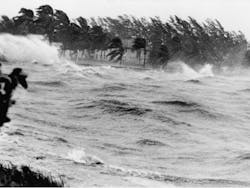Building a Microgrid that Stands its Ground in the Storm-tossed Caribbean
The Caribbean islands, especially the northern islands that include The Bahamas, are often hit hard by hurricanes and storms that can knock out power and cut off essential services. As a result, the region — slammed by Hurricanes Doria, Maria and Irma — is ripe for microgrid development.
This is especially true since many of the islands rely on stand-alone diesel generators that can be costly, polluting and subject to fuel delivery disruptions due to storms.
Microgrids act as an alternative, incorporating cleaner fuel sources, such as solar, and cutting the costs of fuel from diesel.
Equally important, new microgrids are being designed to operate through the islands’ fierce, hurricane winds and heavy rains.
Resort builds microgrid in the Bahamas
Such is the case with an off-grid microgrid, expected to be complete by mid-September, that is being installed at the Chub Cay Resort and Marina in The Bahamas.
Now powered by stand-alone diesel generation, the resort is subject to outages from hurricanes, said Justin Cunningham, general manager of Compass Group, which is based in The Bahamas and installing the microgrid. Often, when a storm is on its way, the company, which operates numerous fossil-fired generators in the Caribbean, shuts off power to protect equipment.
Funded entirely by the resort owners, the Chub Cay Microgrid was designed to withstand 180-mile-per-hour hurricane winds, includes 4 MW of solar and 10 MWh of battery storage and microgrid controls.
The resort is now served by two Tier 2 diesel generators with a total capacity of 2.7 MW. When the microgrid is operating, diesel will be used 5% to 10% of the time, rather than 100% of the time. The microgrid’s controls will allow for use of the diesel when there isn’t enough solar plus storage available.
“The goals of the project are to reduce diesel use, provide resilience and reduce the carbon footprint of the resort,” said Cunningham.
Join the editors of Microgrid Knowledge for a live webinar on Remote Microgrid Best Practices on September 14 – Register Now
Girding the microgrid for hurricanes
To ensure the microgrid can withstand hurricane force winds, Compass added elements that increased the overall cost of the microgrid by 5% to 7%.
For example, the design addresses the potential for damage from wind by increasing the number of bolt contact points between the panels and their backing, said Cunningham.
The company also installed 2,000 ground screws — each 4 inches in diameter and 82 inches long — to ensure that the solar system would resist being lifted during a hurricane.
The bifacial solar panels collect solar radiation from direct sunlight on the side facing the sun and from ground reflections on the side facing the ground. Because the region is characterized by a light-colored limestone ground cover, the ground is expected to provide reflection that will boost the solar system’s output, said Cunningham.
The microgrid tests that idea, but the cost and calculations related to solar panel operation of the project are based solely on the radiation coming from the sky-facing portion of the panels.
“We thought the bifacial panels were good for our client and beneficial to the project as a whole,” said Cunningham.
Not the first
Compass Solar team, courtesy Compass Solar
This isn’t the first microgrid that aims to provide resilience in the storm-tossed region. In 2019, before Hurricane Dorian struck, microgrids were already on their way due to a collaboration between the Rocky Mountain Institute, The Bahamas government and Bahamas Power and Light, which services 21 of the islands. Those entities have been working since 2015 to reduce the islands’ reliance on diesel.
The first project from that effort is being developed on Ragged Island, a community that had much of its energy infrastructure destroyed by Hurricane Irma. That project was the focus of a 60 Minutes piece.
Chub Cay Microgrid, the latest microgrid project in The Bahamas, was developed over a two-year period.
The Compass Group, which launched in 2005, began its efforts with traditional power development, including diesel generators. In 2016, legislative changes created an opening for solar in The Bahamas, and the company moved into renewable energy.
More and more, the Compass Group is trying to add more renewable energy to existing diesel plants in the Caribbean, especially since hurricanes now strike nearly every year.
“We’re trying to help our clients reduce their carbon footprints and be more resilient with battery energy storage and microgrids,” said Cunningham.
Join us on September 14 for a live webinar on Remote Microgrid Best Practices – Register Today
About the Author
Lisa Cohn
Contributing Editor
I focus on the West Coast and Midwest. Email me at [email protected]
I’ve been writing about energy for more than 20 years, and my stories have appeared in EnergyBiz, SNL Financial, Mother Earth News, Natural Home Magazine, Horizon Air Magazine, Oregon Business, Open Spaces, the Portland Tribune, The Oregonian, Renewable Energy World, Windpower Monthly and other publications. I’m also a former stringer for the Platts/McGraw-Hill energy publications. I began my career covering energy and environment for The Cape Cod Times, where Elisa Wood also was a reporter. I’ve received numerous writing awards from national, regional and local organizations, including Pacific Northwest Writers Association, Willamette Writers, Associated Oregon Industries, and the Voice of Youth Advocates. I first became interested in energy as a student at Wesleyan University, Middletown, Connecticut, where I helped design and build a solar house.
Twitter: @LisaECohn
Linkedin: LisaEllenCohn
Facebook: Energy Efficiency Markets

